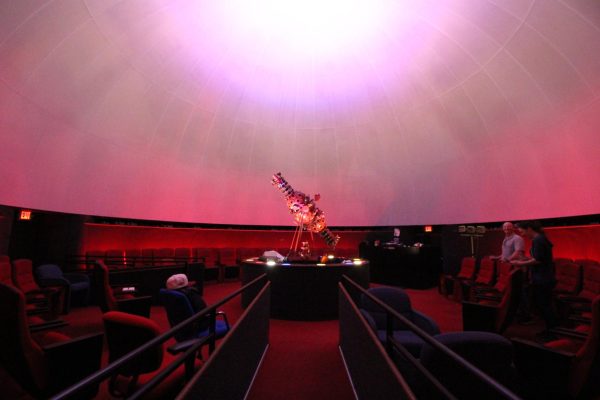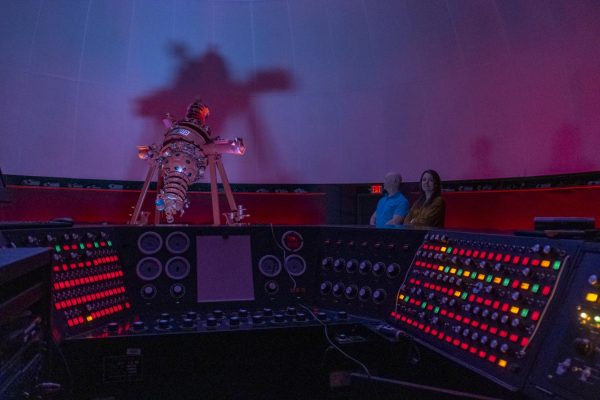Did you know there was a time when Santa Rosa Junior College students could smooch with their crushes under the stars in comfy recliners while sitting next to a family just trying to learn about our solar system’s celestial bodies? Believe it or not, SRJC once had a working planetarium on the Santa Rosa campus at Lark Hall.
According to astronomy instructors Keith Waxman, and Laura Sparks, who also serves as Mayor of Cotati, the planetarium has been a defining feature of the Santa Rosa campus for more than four decades. They believe that not only is it vital that SRJC has a working planetarium once again, but that it can help alleviate some of the college’s recent decline in enrollment.
Waxman’s connection to the planetarium runs deep. His father, former SRJC astronomy instructor Gerald Waxman, played a pivotal role in Lark Hall’s establishment and the planetarium’s construction in the ‘70s. His favorite movie was “2001: A Space Odyssey,” which is why he designated room 2001 for the planetarium. The planetarium opened in 1980 and has been dazzling students and the wider Santa Rosa community — including thousands of busloads of school children — with a view of the stars ever since.

Former planetarium director Ed Megill calculated that over the course of its life, the planetarium had at least 800,000 visitors come through its doors, almost twice the population of Sonoma County.
In fall of 2018, two years after Megill’s retirement, the planetarium closed due to an ongoing structural deficit in the SRJC budget; all staff were either let go or reassigned.
“Due to the age of the facility, which has never undergone structural renovation, the college plans to perform a full assessment of the viability of the building and equipment. Potential plans for renovation will be considered following this assessment. The planetarium will remain closed until spring 2019 at minimum. No date has been set to reopen the facility,” a 2018 college district press release stated.
Waxman said administrators told him and Sparks that the planetarium wasn’t financially sustainable in a meeting years ago, though at the time, it was bringing in thousands of people who could eventually enroll at the college.
“It was really a lack of foresight of the previous administration and we hope the new administration will see things a different way,” Waxman said.
Recently the planetarium developed roof leaks, which halted shows, but should be patched soon.
“The District is currently working with the contractor to determine the best timing to begin the project to minimize impact on classes,” said Sarah Laggos, SRJC interim director, strategic communications, government and public relations. “Once the re-roof project is completed, the District will conduct a structural assessment of the planetarium to determine the scale and scope of needed renovations.”
Once this is finished, the SRJC planetarium can host shows again, but its outdated tech may soon prove to be its Achilles’ heel. The Opto-Mechanical Star projector SRJC uses is likely the only projector of its kind still in operation in the world, according to Sparks.
Even more unique, it may be the only one ever painted orange, according to astronomy assistant John Blumert. It’s so old that representatives from the Japanese company GOTO, which made the projector, requested to have it shipped to them to place it in the company’s museum, according to Waxman. The department had a budget to have GOTO come to service the machine yearly, but since losing that in 2016 the planetarium has been running on “prayers,” Sparks said.

They have been forced to scrounge eBay for spare parts when the machine breaks down, and without any dedicated planetarium staff, astronomy assistants like Blumert have been the last line of defense in fixing the machine. Blumert said the machine is so old he’s yet to find a manual online. He added that nothing inside the planetarium is digital except for a single computer. “We’re really learning it from the ground up,” Blumert said.
A modern projector would require a new electrical system in the building, a new dome interior and a new control panel. “The general public wants to be amazed,” Waxman said, “and that [new system] would draw a lot of people.”
An architect the district hired in 2019 to perform a feasibility study for a complete renovation of the planetarium estimated it would cost $6.6 million to get new equipment, a new dome, seismic retrofits and Americans with Disabilities Act (ADA) retrofits.
However, a more modest “refresh” to the building with a new projector and all the necessary accompaniments, new chairs and a new sound system would cost about $2.5 million, as long as those changes did not trigger the need for seismic and ADA updates to the building. Sparks and Waxman also believe in the need for planetarium staff, whether full or part time, to give the facility the attention it needs — and in their eyes — deserves.
Despite these setbacks, Sparks and Waxman want the community to know the planetarium continues to support the astronomy program. “We offer classes at SRJC that are special, like the Astronomy 12 class, and we use the planetarium for that,” Sparks said. Astronomy 12 is a three-week class with a lecture component in the planetarium followed by two weeks of stellar observation at Lake Sonoma.
“This is still a space that supports our academic program that is in constant use with astronomy students so it is absolutely integral,” Sparks said.

Waxman has hosted planetarium movie nights for his classes, including one last semester where he showed “Interstellar.” SRJC freshman Finn Robertson, an astronomy student who attended the movie night said, “It was cool to see something so integral to the public’s perception of space in an actual planetarium.”
He recalled how Waxman used two classroom video projectors to fill each half of the planetarium’s dome with the movie. “I don’t know why we don’t use it more often,” Robertson said.
There is another planetarium in town at Piner High School, where Kurt Kruger, in his 35th year of teaching, runs the Science Position Astronomy Research Query (SPARQ) Center, which opened its doors in 2014.
He’s a big fan of SRJC’s operation. “As a young man, the SRJC planetarium inspired me to do what I’ve been doing,” he said.
While it’s a facility on campus, “it’s also a public resource that inspires young people.”
As the only currently operable planetarium around, the SPARQ center is responsible for fulfilling all of the field trips from local elementary schools. “I keep up, but I can use the help to meet demand and the need is definitely there,” Kruger said.

He hopes that SRJC is mindful of the future, as he sees the planetarium not only as a good PR and advertising tool, but as “an investment in the community.”
In response to questions about reviving the SRJC planetarium, Laggos said, “Recognizing the current limitations of technology, staffing, fiscal resources and the facility, SRJC is exploring a variety of solutions to offer educational opportunities in astronomy that are fiscally responsible and support student success.”
For now, the planetarium awaits its roof repairs, which are supposedly coming soon. Immediately following those repairs, the astronomy team plans to put on shows with their current equipment while they petition and await for an investment into modern technology.
“This is one of the things that makes the SRJC truly special. It would be a real loss to let it go,” Sparks said, to which Waxman added, “To keep it would be a boost to the school, and I think the school over some number of years will see their enrollment increasing.”
Kruger agrees, and thinks it will drive people to the college.
“They gotta bring it back,” Robertson said. “Whatever plan there is to bring it back, I’m on board with that.”








